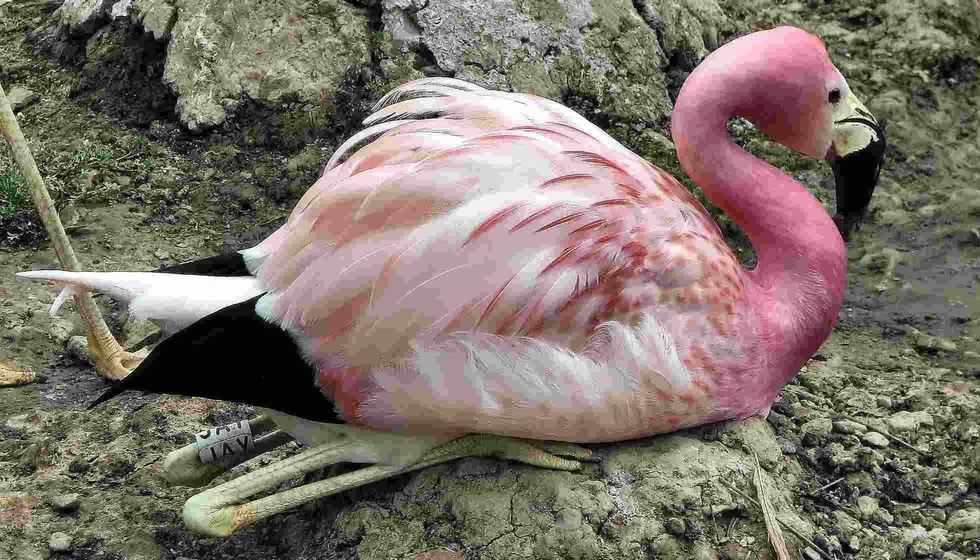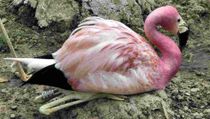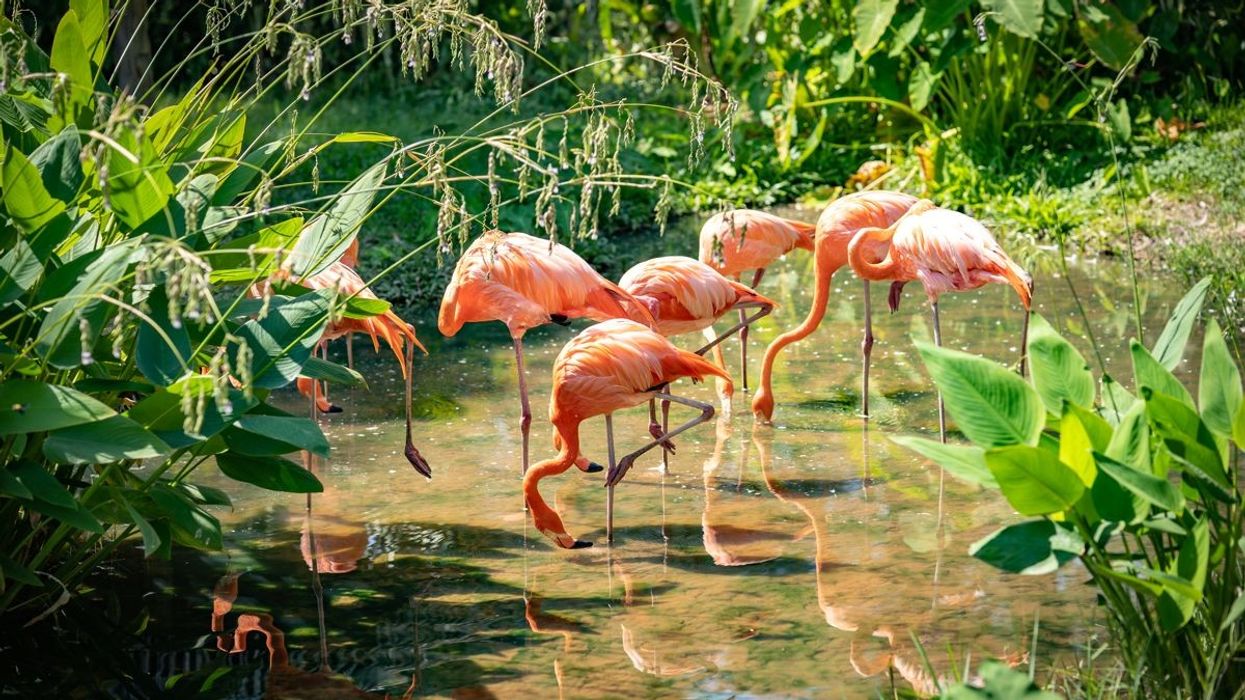Flamingos are a well-known group of birds mostly noted for their bright pink plumage. The birds are found all over the world, especially in salt flats and other marine habitats.
Here we will talk about the Andean flamingo (Phoenicoparrus andinus) that is extant in the high Andes mountains of South America. It is found in places like northwestern Argentina, southern Peru, north-central Chile, and western Bolivia.
The bird was formerly known as the Phoenicopterus andinus, but since 2014 it has been placed in the Phoenicoparrus genus. Apart from its beautiful pink and white plumage, the species is also known for its distinct yellow legs and feet, which are only seen in this species.
The birds migrate during the winter months in search of food, and it is closely followed by the breeding season. Currently, the Andean flamingos are classified as vulnerable because of their lowering population.
Want to know more Andean flamingo facts? Keep reading to know all about them! Also, check out our articles on greater flamingos and lesser flamingos.
Andean Flamingo Interesting Facts
What type of animal is an Andean flamingo?
The Andean flamingo (Phoenicoparrus andinus) is one of the best-known species of flamingos.
What class of animal does an Andean flamingo belong to?
Andean flamingos belong to the class Aves, and the genus Phoenicoparrus. Before 2014, this species was categorized under the Phoenicopterus genus.
How many Andean flamingos are there in the world?
The population of Andean flamingos has been declining drastically, mainly due to the adverse effects of mining. Even though the exact population isn't known, an atrial survey during the summer of 2018 showed 11,607 individuals.
In the '90s, the population drastically declined from 50,000 to 100,000 flamingos to 34,000 flamingos. Some sources also state that there are only 33,927 birds left.
Where does an Andean flamingo live?
Andean flamingos are extant in the Andes mountains of South America. These birds are mainly found in the Chilean Andes which includes southern Peru, the north-central part of Chile, the western side of Bolivia, and northwestern Argentina.
What is an Andean flamingo's habitat?
The Andean flamingo habitat is described as neotropical. These birds are mainly found in areas with brackish water. It is quite common to picture these birds in salt lakes and marine lagoons.
These flamingos reside in the Andes mountains at an elevation of 8,202-16,240 ft (2,500-4,950 m). This species prefers alkaline water bodies that have soft sediments at the bottom.
These birds mainly dwell in areas with scanty vegetation. During the winters, Andean flamingos migrate to areas of lower elevation in search of food. The Andean flamingo has a diverse range of habitats compared to James's flamingo and the Chilean flamingo.
Who do Andean flamingos live with?
Andean flamingos are known to live in big flocks containing up to thousands of birds. The whole flock moves around during the year in search of food. Their flocks are especially active during the daytime. Andean flamingos do not come in close contact with humans.
How long does an Andean flamingo live?
The exact lifespan of an Andean flamingo is yet to be known. However, in captivity, these birds can survive to be 60 years old.
How do they reproduce?
Andean flamingos are monogamous and the pairing can last for several seasons. Males perform a courtship display for females by showing their beautiful pink and white plumage.
Breeding in this species happens mainly from December to January. There can be slight variations in the breeding season due to the pattern of rainfall. Sometimes Andrean flamingos reside in the same breeding grounds as James's flamingos and Chilean flamingos.
Andean flamingos make nests out of the mud with the help of their long beaks. A cone-shaped bowl is made on top of the nest, and the birds also make a moat around the nest.
Female flamingos lay one to two eggs, and one egg is laid at a time. The egg is pinkish white, and both parents incubate the egg for 27 to 31 days.
When chicks hatch from the egg, the young birds are covered in white or gray down feathers.
After living in the nest for a week, the chicks form crèches or groups and only a few adult birds look after the chicks. It may take the chicks up to ten months before they can feed independently.
Adult flamingos produce crop milk which the chicks feed on. It might take an Andean flamingo three to six years to reach sexual maturity to take part in the breeding season.
What is their conservation status?
The Andean flamingo is currently classified as Vulnerable in the International Union for Conservation of Nature Red List.
Andean Flamingo Fun Facts
What do Andean flamingos look like?
When we are talking about flamingos, the most striking thing has to be their plumage. The bright pink and pure white plumage is elegant and attractive.
The Andean flamingo has a brighter pink or red plumage in its head and neck regions. In contrast, black feathers are present on the end of their wings as well as on their tails.
We cannot mention the physical description of a flamingo without describing its beautiful long legs. The Andean flamingo is known for having long yellow legs.
The feet contain three toes, and the webbing on the feet helps the bird to wade through water. Apart from the yellow legs, another unique characteristic of an Andean flamingo is the red dot that is present between the nostrils.
The strikingly long and curved bill of the bird is usually black with a hint of yellow. Even though the bills are deep, flamingos lack teeth so the birds mainly feed on algae by filtering water.

How cute are they?
Andean flamingos are adorable. At the same time, these birds look majestic because of their long yellow legs and feet.
How do they communicate?
We need to know more about the communication form of Andean flamingos. However, one of the distinct ways of communication is the wing salute which is used to show off the bright color of its plumage.
Flamingos are also known for making a honking sound like that of geese. During mating, as well as when the bird is irritated, flamingos make growl or grunt sounds.
How big is an Andean flamingo?
The average height range of an Andean flamingo is 3.2-4.5 ft (1-1.4 m). The long yellow legs do add a lot to the bird's height. This species is much larger than the James's flamingo which has an average height of 2.9 ft (91 cm).
How high can an Andean flamingo fly?
The average flying speed of the Andean flamingo is 37 mph (60 kph). These flamingos have a long wingspan of 3.2-5.2 ft (1-1.6 m).
How much does an Andean flamingo weigh?
The average weight range for an Andean flamingo is 3.3-9 lb (1.5-4.1 kg).
What are the male and female names of the species?
There are no separate names for referring to males and females of this species.
What would you call a baby Andean flamingo?
A baby Andean flamingo is called a chick.
What do they eat?
The Andean flamingo is herbivorous and it is mainly a surfaced feeder. The bird uses its long mandible to catch any food that might be present in the water.
Algae is the most common food in the Andean flamingo diet, and it also acts as a good source of Beta-carotene which gives the flamingo its iconic pink color. One of the most common algae eaten by these birds is blue-green algae (Spirulina plantensis).
Are they aggressive?
Male flamingos can behave aggressively during the breeding season. Other than that, flamingos aren't aggressive and they are social birds that live in huge flocks.
Would they make a good pet?
No, Andean flamingos are extant in the high Andes of South America, and the bird isn't meant to be kept as a pet. As a vulnerable species, keeping an Andean flamingo is the same as illegally poaching these birds.
Did you know...
Flamingos are known to eat upside-down by catching the food in their bill and using their tongue as a sieve.
In the past, Andean flamingos were hunted for their fat which was believed to be a cure for tuberculosis.
A flock of flamingos is known as a colony.
Why are Andean flamingos endangered?
Mining is one reason why Andean flamingos are now endangered as it led to a decrease in their populations. In addition, high quantities of Borox are present in their food sources due to human activities which may have led to increased vulnerability.
Humans also participated in illegal egg hunting. The removal of essential water bodies has led to a dip in the population trend.
Are they the rarest flamingos in the world?
No, Andean flamingos aren't the rarest flamingos in the world. However, this species does live close to the rarest flamingo species, James's flamingo, also known as the lesser Andean flamingo.
Here at Kidadl, we have carefully created lots of interesting family-friendly animal facts for everyone to discover! Learn more about some other birds including Lesser Flamingo or Grey Crowned Crane.
You can even occupy yourself at home by drawing one on our Andean flamingo coloring pages.










